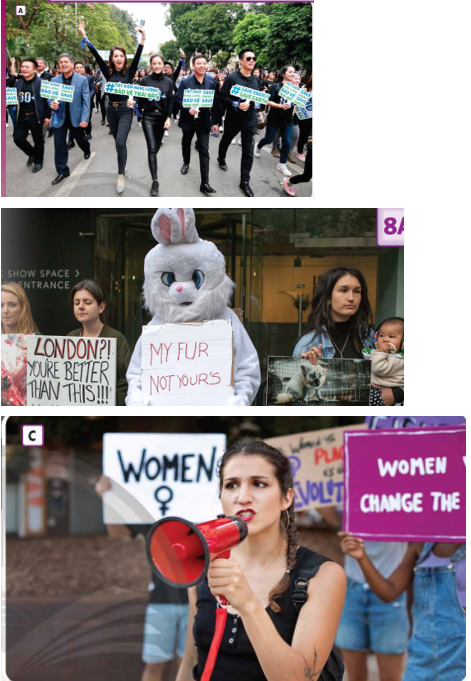Giải SGK, SBT Unit 8. Change the world Friends Global
Giải SGK, SBT Unit 8 Friends Global
3 Complete the sentences with the correct form of the verbs below.
(Hoàn thành câu với dạng đúng của động từ dưới đây.)
|
answer |
interact |
enter |
try |
Jack owns a little shop downtown. Years ago his business was not really good, but last year he learned about social media campaigns and started to benefit from them. He got his customers 1____ with him and learned more about their preference and choice. He once had his customers 2____ a contest in which they were made 3____ questions about his shop and products. With the help of different platforms, he has improved the image of his business and can earn quite a lot. However, he keeps getting himself 4____.
Protest
I can talk about local and global issues.
1 Match (1-7) with (a-g).
(Nối (1-7) với (a-g).
|
1 shout 2 hold up 3 go on 4 listen to 5 hold 6 sign 7 demonstrate against |
a a demonstration b a petition c speeches d a rally e inequality f slogans g placards |
2 Listen to a conversation between Ewan and Emily. Which of the things below do they mention?
(Hãy nghe cuộc trò chuyện giữa Ewan và Emily. Họ đề cập đến những điều nào dưới đây?)
|
famine |
globalisation |
global warming |
|
homelessness |
immigration |
unemployment |
4 Match the words below with the situations.
(Nối các từ dưới đây với các tình huống.)
|
disease |
global warming |
homelessness |
terrorism |
unemployment |
1 We interviewed Tom, who had been living on the streets for a year. ____________
2 All Americans will remember 11 September 2001, when two planes crashed into the World Trade Center. ____________
3 Ebola, which is a virus, has killed thousands of people in West Africa. ____________
4 My brother, Jack, who has got a degree, still hasn't been able to find a job. ____________
5 The weather in the Caribbean, where there have been extremely strong hurricanes, has been the worst on record. ____________
5 Complete the sentences with the nouns below.
(Hoàn thành câu với các danh từ dưới đây.)
|
censorship |
famine |
gender inequality |
|
immigration |
nuclear weapons |
racism |
1 Banning controversial books is an example of _________.
2 The British population has increased because of _________and 12% of UK residents were born outside the country.
3 Although there is less _________today, African Americans still find it more difficult to find jobs than white Americans.
4 Considering how much food we throw away in developed countries, it's a crime that _________ continues to affect a large part of the world's population.
5 More and more countries have _________, and that makes the world more dangerous, not safer.
6 Although _________has been tackled in places like universities, there is discrimination against women in many places.





 uccessfully in some places is putting up lifesize cardboard police officers. It seems all 7 ____ some people need is a gentle reminder to act responsibly.
uccessfully in some places is putting up lifesize cardboard police officers. It seems all 7 ____ some people need is a gentle reminder to act responsibly.









